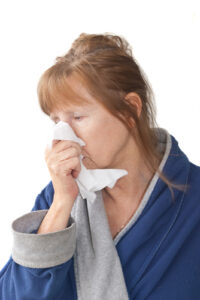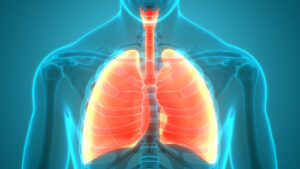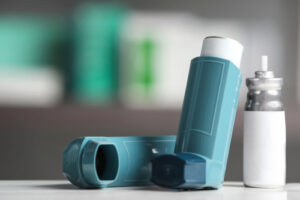 Every mucosal surface on your body is colonized by a distinct group of microbes, including your gut, lungs, and nasal passages. Far from causing harm, these microbes “teach” your immune system to tolerate dietary proteins and other harmless allergens in the environment. When these resident teachers are disrupted it can result as a worsening of your allergy symptoms. In this article we hope to highlight what steps you can take to alleviate your symptoms.
Every mucosal surface on your body is colonized by a distinct group of microbes, including your gut, lungs, and nasal passages. Far from causing harm, these microbes “teach” your immune system to tolerate dietary proteins and other harmless allergens in the environment. When these resident teachers are disrupted it can result as a worsening of your allergy symptoms. In this article we hope to highlight what steps you can take to alleviate your symptoms.
Allergies and Microbes
Are you suffering from seasonal allergies? A disruption of your microbes could be to blame. There are a lot of research papers looking into how the disruption of the microbial flora in our body can greatly impact our health in a myriad of ways. The ability to manipulate the microbiota using dietary and lifestyle interventions is an exciting new treatment philosophy that has many health practitioners excited for what the future holds. This research also calls into question the dangers of antibiotic use in children.
The Hygiene Hypothesis
Originally proposed in the late 1980s to explain the decreased prevalence of chronic hay fever in larger families, the modern hygiene hypothesis has evolved to suggest that our insistence on cleanliness and lack of exposure to environmental microbes in the developed world deprives our bodies of immune stimulation, disrupting normal immune development and thus increasing the risk for allergic disease.
Several epidemiological studies have provided support for the hygiene hypothesis. Studies have shown that people who have indoor pets, live on a farm, or drink unpasteurized milk are less likely to have allergies. On the other hand, early-life environmental influences that are known to disrupt the microbiota increase the risk for allergic disease. Antibiotic use, cesarean birth, and formula feeding are all associated with increased susceptibility to asthma and allergies later in life.
Recent advancements in sequencing technology have allowed researchers to compare the gut microbiotas of allergic and nonallergic children. Children with allergies tended to have increased abundance of Staphylococcus, Clostridium, and Escherichia species, while numbers of Lactobacillus and Bifidobacteria are significantly reduced compared to healthy children.
Taken together, these studies suggest that exposure to a diverse array of microbes early in life effectively “trains” our immune system, teaching it which substances in the environment are harmful pathogenic microbes and which are harmless friendly microbes, dietary proteins, and many environmental allergens.
Food Allergies: All Roads Lead Back to the Gut
Food allergy has become an epidemic in our modern world. Whereas a food allergy was considered an anomaly just a few decades ago, today one in 13 children in the United States suffers from a life-threatening anaphylactic food allergy. And this figure does not include those with celiac disease, non-celiac gluten sensitivity, lactose intolerance, or any other type of food intolerance. As the major site of dietary absorption and the home to 80 percent of your body’s immune cells, it makes sense that the gut is a key player in the pathology of food allergies.
Your gut is lined with millions of epithelial cells that are responsible for maintaining a barrier between your gut contents and your bloodstream. In a healthy gut, small nutrients are absorbed, but large dietary proteins are unable to cross this barrier and enter the bloodstream. However, when the intestinal barrier becomes compromised (i.e., “leaky gut” syndrome), these large dietary proteins are able to enter the blood, stimulate an immune response, and produce symptoms characteristic of various allergic diseases.
Studies have shown that disrupting the gut microbiome with antibiotics or a low-fiber diet is capable of causing this increased barrier permeability. On the other hand, certain strains of bacteria in the genus Clostridia are able to protect against intestinal permeability to food allergens. Researchers are looking into developing probiotics containing these strains as a potential treatment for food allergies.
 Allergies of the Airway: Leaky Lungs?
Allergies of the Airway: Leaky Lungs?
The incidence of allergic airway diseases has also risen dramatically in recent decades, with allergic asthma and allergic rhinitis now affecting around 20.3 million Americans and 50 million Americans, respectively. Many more people suffer from less severe allergies of the airway and sinuses. For quite a while, it was thought that the lungs were completely sterile. Only recently, with the development of culture-independent techniques, has a distinct community of microbes in the lungs been identified.
Interestingly, the epithelium of the gut is structurally very similar to the lung endothelium, and inflammation tends to happen in both areas in people with allergic airway diseases. While not many studies have assessed lung permeability, it seems plausible that the mechanisms that lead to leaky gut may also cause “leaky lungs.” Like in the gut, microbial communities likely have a major impact on the integrity of the lung tissue.
The Histamine Connection
Histamine is an extremely important compound in the body. It acts as a neurotransmitter and regulates production of stomach acid, blood vessel permeability, and contraction of skeletal muscle. It’s also a major component of the immune response and thus a key mediator in allergic reactions. Many microbes that reside in the human gut are capable of producing histamine. These microbes produce an enzyme called histidine decarboxylase, which converts the histidine present in various proteins into histamine. The more of these microbes you have, and the more histidine you consume, the higher the amount of histamine that can be produced in your gut. Histamine can then be absorbed by epithelial cells and traffic to various sites of the body, exacerbating allergic symptoms.
Some have speculated that individuals with SIBO may have an overgrowth of histamine-producing bacteria, such as Lactobacilli, in their small intestine. Although Lactobacilli are an important genus of beneficial bacteria in the gut, they are also major producers of histamine and can cause problems when overrepresented in the small intestine. Restoring a healthy balance of gut flora is the best long-term solution to resolving a histamine issue.
 7 Steps You Can Take to Improve Allergy Symptoms
7 Steps You Can Take to Improve Allergy Symptoms
So does this mean that I can throw away my EpiPen or inhaler? Not exactly. Severe allergic reactions are not something to mess with, and most people with anaphylaxis will always have some degree of sensitivity. However, there are several things you can do to reduce the severity of allergy symptoms and improve your overall quality of life.
- Take probiotics or eat fermented foods
Fermented foods and probiotics can help bring the microbiota and your immune system back into balance. If you are sensitive to histamine, try histamine-degrading strains such as Bifidobacteria infantis and Lactobacillus plantarum.
- Eat plenty of fermentable fiber
Complex fibers like plantains, cassava, or sweet potatoes are fermented by gut bacteria, resulting in the formation of short-chain fatty acids (SCFAs) like butyrate, acetate, and propionate that regulate the immune system. Butyrate has been shown to reduce intestinal permeability to dietary antigens in a mouse model of food allergy and induce regulatory T cells, which suppress immune responses. In mice, propionate has been shown to reduce allergic airway disease.
- Get tested for sensitivities and avoid inflammatory foods
Continuing to eat foods you are sensitive to can cause low-grade inflammation and impair gut healing. Consider keeping some activated charcoal on hand for those times that you accidentally eat something you are sensitive to. Many people find that it can provide quick and safe relief for food allergies.
- Try a low-histamine diet
A low-histamine diet can often reduce the severity of allergy symptoms. Foods high in histamine include fermented foods, aged cheese, citrus fruits, fish, shellfish, avocados, spinach, cocoa, and leftover meat, to name a few. Consider taking NAC (N-acetyl) a natural antioxidant that improves lung health. Also try to use antihistamine herbs like thyme and holy basil in cooking.
Raw honey contains both beneficial bacteria and trace amounts of pollen picked up by the bees from local plants. Consuming raw honey produced in our local Roanoke area can help to “educate” your immune system to tolerate these local pollens.
- Get adjusted
Adjustments to the cervical spine have been shown to improve the breathing ability by promoting sinus drainage. This improved drainage can help to reduce the likelihood your allergy symptoms are going to turn into a more sinister sinus infection.
- Try Acupuncture
Similar to an adjustment, acupuncture can reduce headaches and improve the movement of fluid trapped in the sinuses. Likewise, many Chinese medicine practitioners use acupuncture to help to balance the body when allergy symptoms are raging.
Our goal at [Core] is to be your wellness and health ally during this allergy season. We are happy to help partner with you to see you become healthier than you have ever been!








